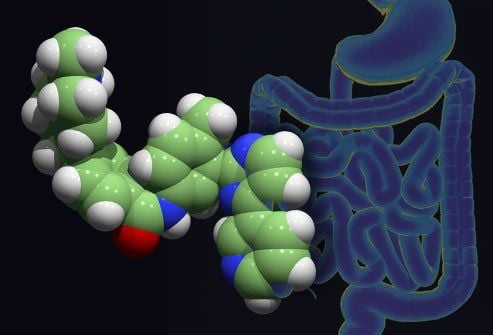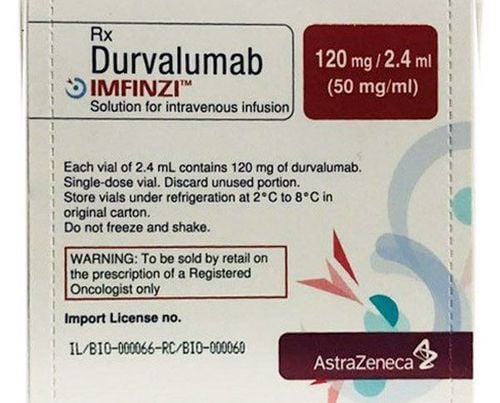This is an automatically translated article.
Gastrointestinal stromal tumor is a rare disease that, if not detected and treated promptly, can lead to death. Therefore, patients need to be diagnosed early and have an appropriate treatment plan.
1. An overview of gastrointestinal stromal tumors
Gastrointestinal stromal tumor, also known as GIST (short for Gastrointestinal Stromal Tumor) - a cancer of the connective tissues and bones. Gastrointestinal stromal tumors can appear anywhere in the gastrointestinal tract (mainly in the stomach, small intestine and colon), and are common in people 50 to 80 years of age.
The cause of gastrointestinal tumors is unknown. However, doctors also discovered a number of factors that increase the risk of disease such as: age, sex, lifestyle, genetics,... The disease can be suspected and detected if there are symptoms such as anemia, abdominal pain, blood in stools or vomiting blood,...
Gastrointestinal stromal tumor begins in the gastrointestinal tract, can grow and affect organs and structures near. The tumor can also spread to the lymph nodes, which can metastasize to more distant organs in the body. Early diagnosis and treatment improve the patient's chances of survival.
2. Treatment methods for gastrointestinal stromal tumors
The choice of treatment method will depend on factors such as: Tumor size, number of dividing cells, location of primary tumor, tumor has metastasized, tumor has ruptured - if rupture then due to spontaneous rupture or surgery,... Specific treatment methods include:
2.1. Surgical treatment of gastrointestinal stromal tumor This is a method of removing the tumor and surrounding healthy tissue. For patients with gastrointestinal stromal tumors, surgery is the standard treatment, which should be performed as soon as possible. In case the tumor has spread to another location, surgery will be difficult to remove it, so the disease will not be cured completely. However, surgery may be considered if the tumor is still localized and has not spread.
Before surgery, the patient should talk to the doctor about the possible side effects during and after this procedure.
2.2. Drug therapy for gastrointestinal stromal tumors This is a method of using drugs to destroy cancer cells. With this method, the doctor puts drugs into the patient's blood (either by mouth or by infusion), the drug will go into cancer cells.
Drug therapy also includes targeted therapy. With the drug method, the patient can be treated with one therapy or a combination of several therapies. This is also part of the treatment plan.
Doctors will continuously evaluate the effectiveness of drugs for the treatment of gastrointestinal stromal tumors. Patients should talk to their doctor about the type of medication being used, the main and side effects, or drug interactions. Patients should also talk to their doctor about any medications they are taking, as they may interact with cancer medications.

Phẫu thuật là cách điều trị chuẩn cho người bị u mô đệm đường tiêu hóa
2.3. Targeted therapy This is therapy that targets genes, proteins specific to gastrointestinal stromal tumors, or targets the environment to help tumors survive and grow. This therapy helps prevent the growth and spread of cancer cells, limiting the risk of damage to healthy cells.
Not every tumor has the same treatment options. Doctors will perform many tests to find out the genes, proteins or factors that affect the tumor and then come up with the most effective treatment plan.
Tyrosine kinase inhibitors (TKIs) are drugs that target specific proteins called kinases that contribute to tumor survival and growth. TKIs are commonly used to treat gastrointestinal stromal tumors. Some specific drugs are:
Imatinib (Gleevec): Usually the first drug used to treat gastrointestinal tumors. The use of drugs improves the patient's prognosis. Medications may be used after surgery to delay or prevent tumor recurrence. If the tumor has metastasized, the patient should receive imatinib for the rest of their life to control the tumor. Side effects of the drug include: fluid accumulation, nausea, rash, diarrhea, mild muscle pain and fatigue, bleeding, hepatitis,...; Sunitinib (Sutent): Works to slow tumor growth. It also inactivates the KIT gene and the process of forming new blood vessels. Doctors often prescribe Sunitinib for patients in cases where imatinib treatment fails or when imatinib has too serious side effects. The side effects of Sunitinib are fatigue, nausea and vomiting, heartburn, diarrhea, high blood pressure, change in taste, decrease in blood cells, change in skin color,...; Regorafenib (Stivarga): Has the effect of slowing the growth of tumors, inhibiting the KIT molecule and inhibiting the formation of new blood vessels in the tumor. The drug is indicated for patients with advanced stage gastrointestinal stromal tumor that cannot be surgically removed, after taking imatinib and sunitinib with no effect (or serious side effects). The side effects of Regorafenib include: Nausea, fatigue, high blood pressure, hand-foot syndrome, diarrhea, hepatitis,...; Some other drugs: Larotrectinib (Vitrakvi), Avapritinib (Ayvakit), Ripretinib (Qinlock),...
In addition, radiation therapy is not usually used to treat patients with gastrointestinal stromal tumors, but it can be used to treat symptoms such as helping to relieve bone pain and stopping bleeding.
2.4. Palliative care - psychology Gastrointestinal stromal tumor and its treatment can have many psychological and patient effects. Dealing with these problems is called palliative care.
Palliative care focuses on improving a patient's feelings during cancer treatment by controlling symptoms, helping patients improve their quality of life. Palliative care should begin as soon as possible, as soon as a patient is diagnosed with cancer. Research shows that patients who receive palliative care at the same time as cancer treatment experience fewer side effects and have a better quality of life.
Palliative treatments include: Medications, dietary changes, relaxation, emotional and spiritual support. Before and during the treatment, the patient should discuss carefully with the doctor about his feelings, the problems he is facing, ... for the best support.

Điều trị u mô đệm đường tiêu hóa bằng liệu pháp nhắm trúng đích
3. Treatment of gastrointestinal stromal tumors by stage
Each stage of gastrointestinal stromal tumor can apply different treatment methods. Specifically:
3.1 Tumor stage localized If the tumor in situ is smaller, the chance of complete resection by surgery is greater. In some cases, just surgery is enough. If the tumor is large or has spread to nearby organs, it is necessary to first treat with imatinib to shrink the tumor and then switch to surgery (neo-adjuvant therapy).
To completely remove the tumor, the doctor may have to remove part of a nearby organ depending on the location of the tumor. Usually, lymph node dissection is not necessary because gastrointestinal stromal tumors do not usually spread to the lymph nodes. If the tumor in situ cannot be surgically removed, targeted therapy is used.
Tumors after surgery have the risk of recurrence and metastasis to other organs. Therefore, after surgery, patients at high risk of recurrence will be treated with imatinib for at least 3 years to prevent and delay recurrence and metastasis (adjuvant therapy).
3.2. Stage Metastatic Tumor Metastasis is when the tumor has spread from the place of origin to other organs in the body. Once at this stage, the patient should talk to the doctor to have the best treatment plan. In many cases, patients with metastatic gastrointestinal stromal tumors can live healthy, normal lives for many years with the option of outpatient oral medication.
Depending on the stage of the disease and risk factors, patients with gastrointestinal stromal tumors can be cured or have a longer survival time. If there are signs that indicate the risk of disease, it is best for the patient to go to the doctor for early diagnosis and treatment, improving the chances of survival.
Please dial HOTLINE for more information or register for an appointment HERE. Download MyVinmec app to make appointments faster and to manage your bookings easily.













